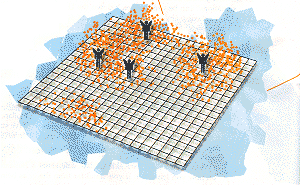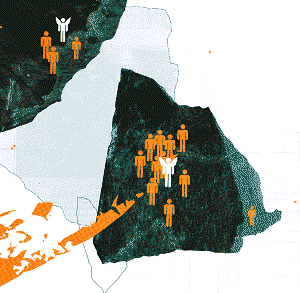 |
ORDINARY MIRACLES
|
|
How do the complexities of the living world arise from dumb matter? A
speck of angelic assistance may be all that's needed.
Michael Brooks
 ARE you ever, when absent-mindedly cleaning the house, troubled
by those deep philosophical questions? You know the sort of thing. How did
we get here? What is the meaning of life? Why does a collection of carbon,
hydrogen and oxygen atoms like me feel the need to ask such difficult questions?
ARE you ever, when absent-mindedly cleaning the house, troubled
by those deep philosophical questions? You know the sort of thing. How did
we get here? What is the meaning of life? Why does a collection of carbon,
hydrogen and oxygen atoms like me feel the need to ask such difficult questions?
The answers probably won't come to you while you're still cleaning, so stop
dusting and pay attention to Sorin Solomon, a physicist at the Hebrew University
of Jerusalem. Solomon has discovered that adaptive, almost intelligent behaviour
can emerge from the interaction of just two very stupid kinds of entity.
We'll call them angels and mortals. From their simple dance comes an explanation
for our very existence.
These ideas are embodied in a game that Solomon developed last year. In a
paper submitted to the National Academy of Sciences, he shows that life gains
the upper hand in what ought to be disastrous circumstances. It has other
happy consequences, too. It shows that financial
markets will survive even in the hands of dunces. In the future it could
even provide you with an army of robot cleaners. So put your feet up, pour
yourself a glass of some-thing refreshing, and drink a toast to Solomon's
angels.
The complexity of any system,
such as life on Earth, must somehow arise from the interaction of its simplest
parts. If you can find and map those simple interactions, whole areas of
seemingly impenetrable complex phenomena should be laid bare. Such "microscopic
representations" can be used to break down the Universe into galaxies, and
a nucleus into protons and neutrons. See how the component parts work, then
put them back together again, and you should have an explanation of the most
complex phenomena.
Solomon and his team work from the bottom up, with what they consider to
be the most basic of ingredients. First they scatter a race of "mortals"
evenly over a square grid.
Life for these beings is bleak,
as every hour a fraction of the population dies. But there is also a ray
of hope, in the form of eternal agents, or "angels", scattered over the board.
The mortals and angels hop around randomly like soot
particles in Brownian motion. There is
only one rule: when mortal and angel meet, the mortal multiplies. There,
in the presence of immortality, a life begins.
What fate awaits this world? Well, that depends on how you look at it. If
you stand far from the playing board, you see only a smeared-out cast and
not the individual players. Given the average population densities of angels
and mortals, you can work out an equation that predicts the average death
rate and birth rate. If the mortals die out faster than they are born, the
race becomes extinct. This way of looking at the world is called the "continuum
approach".
But with Solomon's microscopic representation, the outcome is starkly different.
Although the population slumps at first, it can recover. "It constitutes
the difference between life and death," says Solomon. Whereas the continuum
approach predicts extinction, the direct simulation uncovers the emergence
of a thriving, developing system. "The continuum is utterly misleading,"
says Solomon.
| CAN RANDOM ENVIRONMENTAL FLUCTUATIONS INCREASE AIR POLLUTION LEVELS? A new paper suggests this possibility. Motivated by the problem of ozone production in urban areas, an Arizona State team (Zonghua Liu, 480-965-2311, zhliu@chaos4.la.asu.edu) simulated a chemical reaction between tens of thousands of hydrocarbons and nitrogen oxides in a two- dimensional airflow. In actuality, the production of ozone requires dozens of distinct chemical species and a chain of sunlight- triggered chemical reactions. Yet in their single reaction between two species the researchers were able, for the first time, to consider how the reactants' size and mass affect their rate of chemical reaction in the complex 2D flow they examined. Moreover, the simulated 2D flow has important similarities to real-life airflows in the troposphere, the approximately 15 kilometers above ground where air pollution can occur. For example, the simulations explored a situation that can sometimes occur in real-life tropospheric flows: "Lagrangian chaos," in which the overall flow of air is regular (completely predictable) but the individual particles in the air move in a chaotic (unpredictable) fashion. In efforts to mimic the repeating cycle of day and night, the researchers incorporated a repeating cycle that influenced the reaction. Most strikingly, however, the chemical reaction rates were increased by up to two times when the researchers added the right amount of environmental "noise," random fluctuations, such as wind-speed variations, whose intensity depends on temperature. As it turned out, the addition of noise caused the behavior of particles to become more spatially and temporally regular. This in turn created favorable conditions for increasing the chemical reaction rate. This result suggests that perhaps environmental noise plays an important role distinct from other effects in generating air pollution. If borne out this would represent the latest natural example of stochastic resonance (Update 121), in which an ordinarily weaker process can be magnified by the right amount of random fluctuations ("noise") in the background. The researchers' next step is to study chemical reactions in more realistic flows. (Zonghua Liu; Ying-Cheng Lai; and Juan M. Lopez, Chaos, June 2002) |
Why should that be? When Solomon looked closely at his game, he found that
some groups of mortals, though completely ignorant of everything around them,
appear to follow the angels around. Thanks to the new births in each angel's
presence, there is an overall increase in the mortal population at these
sites. The new mortals move randomly away from their birthplace, but if the
angel's random hop is onto their turf, they multiply again. The result is
islands of life that move around the playing area, following their angels.
Islands can grow, join and split up again. Small islands are unstable, but
can become more stable when they merge to form larger islands. Because of
this apparently adaptive behaviour, the pockets of population survive
and proliferate. Ever the underdog, life simply blows a raspberry at the
big bad world.
But Solomon's mortals are totally unaware of their environment, and have
no life goals. "We start with very stupid microscopic components.
The islands are made up of individuals who don't have the slightest clue
of where they are going," says Solomon. "The microscopic agents are nonadaptive,
but the collective object has a behaviour which can be called adaptive."
This is not a conclusion that can be drawn from other simulations, says Solomon.
He points to "adaptive agents", generated by John Holland, a simulations
expert at Michigan State University. According to Solomon, Holland's agents
have complexity already built in. "They have strategies, efficiency criteria,
and make choices," he says. "Since you are putting it in, you can't claim
that you are studying the emergence
of adaptability."
Holland takes the opposite view. He says he would hesitate to describe the
behaviour of Solomon's system as being adaptive. He likens it more to a kind
of self- regulation maintained by feedback. For instance, when the
body's sensors register a high temperature, they trigger the sweating mechanism.
"Of course there are no sharp lines here, so the distinctions are almost
a matter of convenience."
Solomon and his colleagues insist their model is genuinely adaptive. "The
islands are not just self-regulating, they are selfserving. They move in
a way that prolongs their life," he says.
If adaptability really does emerge at this basic level, the implications
are far-reaching. For instance, the angels could represent the necessities
of life, such as edible animals for a population of carnivores. Most researchers
into population dynamics would treat the animals
as a resource that is spread evenly across the whole area. With just a few
animals, the situation would look grim: there just wouldn't be enough meat
in a given area to allow the carnivores to survive. But Solomon's microscopic
view reveals that a few animals are bound to be in just the right place,
allowing a few bands of carnivores to become established.
Jeff Kirkwood, a population dynamics researcher at Imperial College, London,
says this close look is particularly valuable when predicting population
growth in a diverse environment. "If you looked 'on average', the conditions
are just hopeless and no one has any right to survive," he says. But if there
are patches where it is possible to survive, some faster-growing species
like pest plants and bacteria can hang in there for ages. "As soon as the
conditions get good in one little area, up they come," says Kirkwood.
 |
| Guardian angels: even though mortals move at
random over the board, they survive by forming
islands that follow the angels around. |
The number of dimensions available
on the playing board turns out to be crucial. If Solomon lets his angels
and mortals move in three dimensions instead of two, the players tend to
cross each other's paths too rarely for life to survive. But with just two
dimensions, life always wins. Even with a high death rate, a single angel
enables life to flourish on Solomon's two-dimensional board.
"This may explain the fact that most ecological systems are two-dimensional,"
says Solomon. Even creatures that can move in three dimensions, like birds,
fish and microbes, tend to stick with one particular level, limiting themselves
to largely two-dimensional movement because their particular angels-be they
light, oxygen or food-tend to be found within a small vertical range.
According to John Beringer, an expert on microbial biology at the University
of Bristol: "Microbes that need oxygen will be found close to the surface
of soil, and microbes that are very fastidious about oxygen concentration
will be found in bands at the appropriate oxygen concentration." Microbes
concentrating on a two-dimensional resource may have been more successful
than their cousins who tried exploiting a three-dimensional feast.
Set up the game in a slightly different way, says Solomon, and it can explain
why there is no such thing as a duckbilled hippopotamus. Instead of a place
in real space, like a stretch of savannah, the playing area could represent
all possible ways in which genes can be arranged. Biologists call this sort
of abstract space a fitness landscape.
Now think of Solomon's angels as the perfect genomes for the habitats and
niches available, and the mortals as species wandering through the fitness
landscape. Far away from the perfect genome,a species will probably fade
out of existence. But around the angels, islands of similar species will
develop.
"The space of species is very sparsely populated-there is nothing in the
'space' between giraffes and elephants, or between lizards and snails," says
Solomon. The finite number of environments that exist on Earth significantly
reduces the number of genomes that can survive.
And what about the chemicals that needed to co-exist
in order to create life? The angels and mortals in Solomon's game have
such simple properties that they could be single molecules. Their playing
space could be something like the Earth's prebiotic oceans, where all that
existed were a few relatively simple compounds. As these primordial chemicals
floated through the waters, one kind of mortal molecule might have encountered
its long-lived angelic catalyst, sparking a self-sustaining chemical
reaction.
Small changes in the surrounding conditions would then produce slightly different
molecular structures. These shadowy reactions, which Nobel prizewinning
biochemist Christian de Duve called "protometabolism", might eventually have
produced RNA, one of the ancient building blocks of life. These must have
been robust and repeatable chemical reactions, not some one-off chance
combination of circumstances, said de Duve.
According to Solomon, the angels and mortals game demonstrates that even
a low concentration of the right chemicals could produce a robust self-sustaining
reaction, eventually leading to the proliferation of life. What might seem
unlikely, given the scarcity of chemicals, needs only the smallest of
chances in order to take root on Solomon's playing board.
There have been other attempts to explain how the complexity of chemical
life arose. Stuart Kauffman of the Santa Fe Institute in New Mexico has produced
simulations that allow a variety of chemicals to react together,in which
he has seen complex chemistry emerge. But Kauffman achieves complexity from
a multitude of substances and interactions, whereas Solomon believes his
angel and mortals simulation starts with the most basic components. "We have
very simple reactions-A catalysing B-and we
get a lot of complexity." Having shown that the chemical adaptability
can come for free, Solomon plans to put in more substances" to see how
different islands would learn to exploit different compositions and compete
with each other.
Another area that could benefit from the angel and mortals simulation is
immunology.Here, the emergence of population islands is not such good
news.Solomon has been working with Israeli immunologists to explain how HIV
can survive in what should be impossible circumstances. Here the simulation
is inverted: antibodies attach themselves to virus particles, which allows
immune cells to mop them up. An antibody has to have just the right sequence
to grab hold of a particular strain of the virus, so the immune system generates
antibodies at random until one fits. Then a flood
of similar antibodies are produced, obliterating that viral strain.
But HIV mutates rapidly. You can imagine strains of virus wandering around
in an abstract genetic space as they
mutate. Every strain will eventually encounter a deadly antibody, and then
the game's up for that strain. But Solomon's simulation shows that, if the
rate of mutation is fast enough, islands of virus proliferate. "We find using
this model that the immune system wins in every confrontation with an particular
HIV strain," says Solomon, "but as the mutant strains become more numerous,
the immune system eventually collapses under their collective pressure.
But never mind the origins of life or the tenacity
of death. What about more important questions, like how to make pots
of money? Think of the game board as an array of investment opportunities,
with the angels representing the profitable ones. Dollar bills flock around
these sites, and when they meet the angels they give birth to baby dollars.
In the gaps between the profitable investments, money lies dead and decaying.
Solomon's simulation shows that financial markets don't need intelligent
investors to work. Money can survive and even proliferate simply by being
multiplied in good investments and reduced in bad ones.
Solomon's ignorant agents can teach us something about
robotics too. Chris Melhuish of the
University of the West of England in Bristol
says he has seen unconscious adaptation occurring in very simple robot systems.
In some cases, he says, complex behaviour can be a manifestation of simple
rules.
Melhuish thinks this kind of characteristic could help roboticians
create swarms of cheap, small "dumb" robots that move through and act on
their environment. Ideally, he would have them perform their small tasks
without being encumbered with senses, computing power or communication
devices.
These little robots might herd around more complex "angelic" control units
with more senses and intelligence, which
give them
new life by performing repairs a providing power. Solomon's simulation
shows that these higher beings could be few and far between, and the dumb
mortals could be very
 dumb
indeed. So it won't cost a fortune to assemble an army of robotic cleaners
that will clean your car and dust your house, self-sufficient and supervised
by the foreman from heaven. Then you'll have to find some other mindless
activity to pursue while musing on the meaning of life.
dumb
indeed. So it won't cost a fortune to assemble an army of robotic cleaners
that will clean your car and dust your house, self-sufficient and supervised
by the foreman from heaven. Then you'll have to find some other mindless
activity to pursue while musing on the meaning of life.
"I wasn't walking
with angels....oh sweet miracle of
life"-RUSH
| The idyllic antithesis - child-like
wholeness - is symbolised by the most powerful baby of all,the Divine Child.
This archetype is present in most cultures in one form or another. For example,
Christian iconography features the Divine Child as a cherub or angel.
The ancient symbology of the alchemists featured the regally robed figure
of the Divine Child to indicate the Philosopher's Stone - which represented
identification with the eternal, and the god within. The Divine Child connects
us with the part of ourselves that is not constrained by our persona or
ego. The Divine Child may appear in dreams as vulnerable
yet inviolable, reminder and guardian of our most precious hopes, aspirations,
impulses and instincts. ["Wake up to your dreams" -Joan Hangar] Second of the holy choirs are the cherubim. This term derives from the Hebrew kerubh, translated to mean, 'the ones who intercede.' In mythology cherubs have most commonly become known as guardians of sacred places. In a biblical context, the casket which held the Ark of the Covenant had two golden cherubs guarding it and two were also said to guard Eden. Elsewhere, representations of these heavenly figures can be seen at the entrances to temples and other places of worship. In Sumer and Babylon, cherubim equivalents became monstrous beings, again guarding sacred places and even kings. In the Near East, the cherubim evolved into the fabulous jin, or genies as we now know them, who are of course guardians of lost knowledge and power.[Predictions July 97] |
Author Michael Brooks is a freelance science writer based in Sussex |
Further reading
Solomon's homepage is
http://shum.cc.huji.ac.il/~sorin/ |
